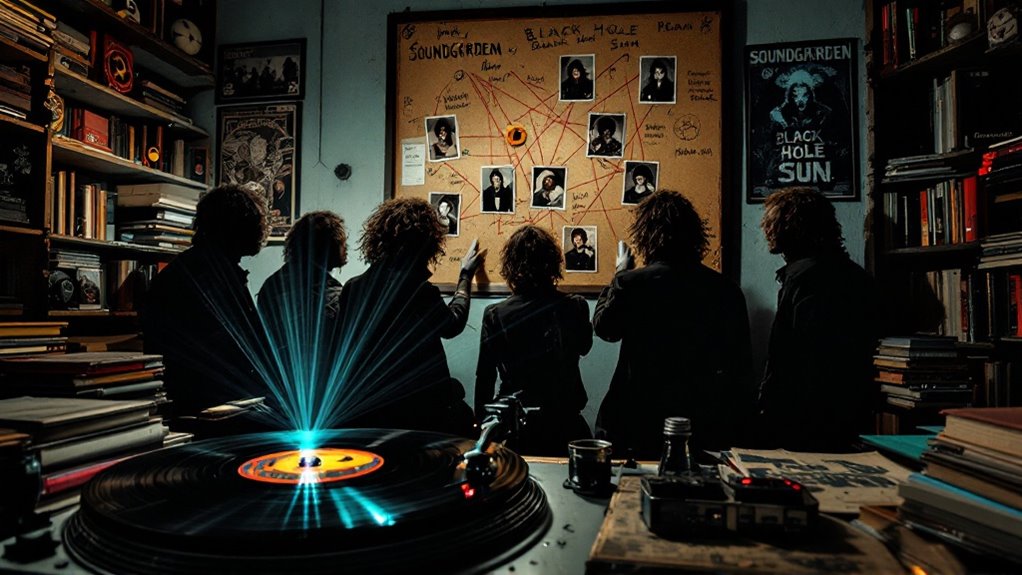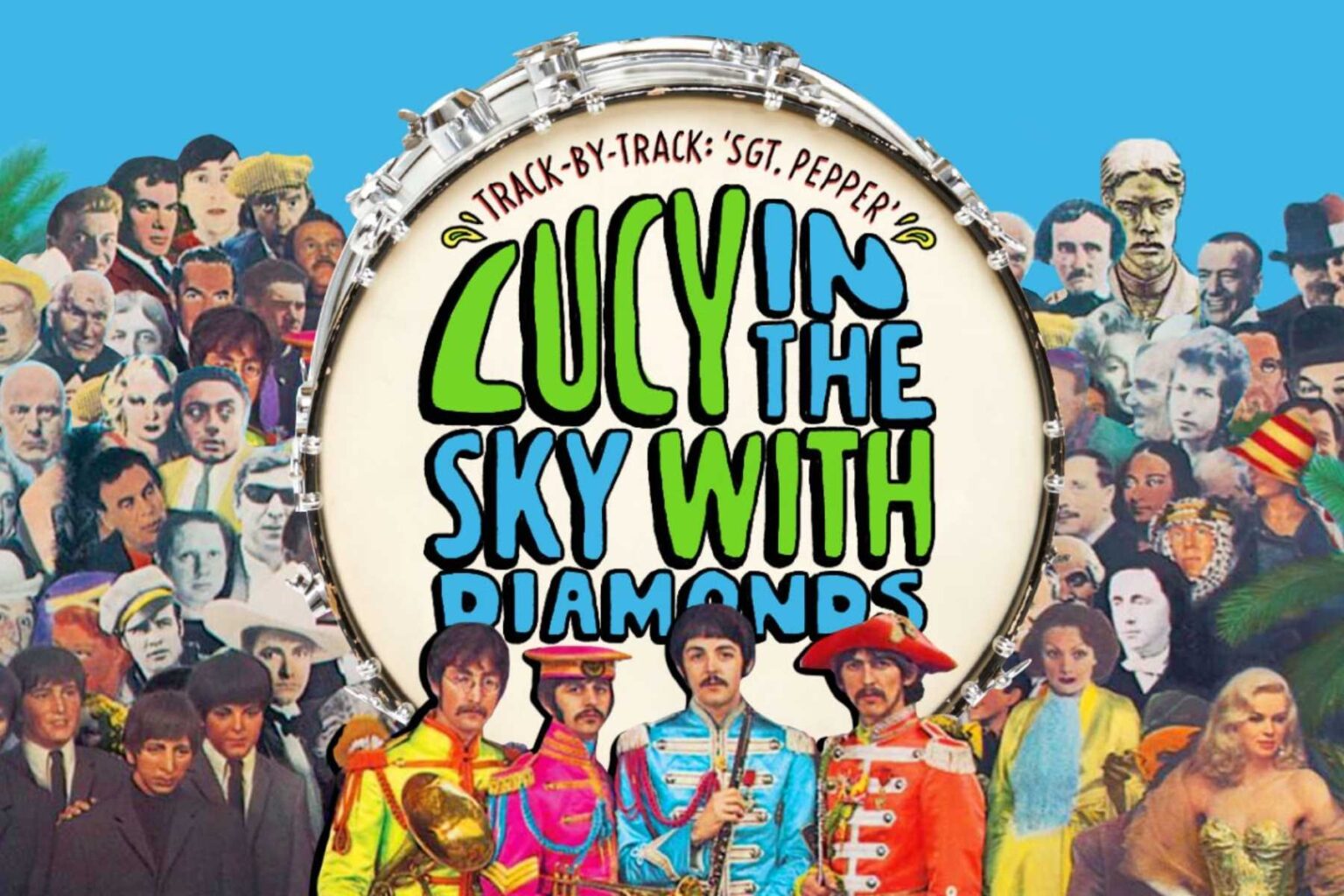Did you know that over 50% of people believe in at least one conspiracy theory? This fascination often extends to the music world, where hidden messages in songs spark endless debates. You might have heard whispers about Hotel California and its supposed Satanic undertones or the infamous Paul Is Dead theory linked to Revolution 9.
Even Lucy in the Sky With Diamonds faced accusations of drug references. These wild claims can make you question what you’re really hearing. Curious about how these and other tracks have been interpreted? Let’s explore these intriguing conspiracies together.
Hotel California and Satanism
Although the Eagles’ hit Hotel California has been the subject of numerous interpretations, one of the most persistent theories connects the song to Satanism. You might be intrigued—or maybe even amused—by how fans have explored the lyrics, convinced of hidden Satanic symbolism. During the 1980s, the song was swept into the whirlwind of the Satanic Panic, where everything from rock lyrics to board games seemed to bear an evil mark. Some believed playing the song backward revealed the chilling message, “Yes Satan, he organized his own religion.” Wild, right?
And then there’s the supposed Anton LaVey connection. The song’s mention of 1969 had some shivering with the thought it was nodding to The Satanic Bible. Despite the controversies, Hotel California topped the Billboard Hot 100, maintaining its place in music history as an influential piece. Don Felder, however, assures everyone that it’s more a hotel critique of the Los Angeles music scene’s darker side, full of excess and illusion—hardly a devilish ritual.
Yet, the imagery of mirrors and traps within the hotel continues to spark imaginations. Despite the band’s explanations, the mystique remains, offering more of a critique of the American Dream’s shadow than any sinister purpose. Who knew a catchy tune could stir up such a devilish debate?
Revolution 9 and Paul Is Dead
The “aul Is Dead conspiracy theory gripped fans in 1969, fueled by the enigmatic track Revolution 9 off The Beatles’ White Album. Envision the intrigue as fans keenly spun records backward, searching for hidden meanings. Revolution 9 became a cornerstone for conspiracy theorists, who claimed to hear “turn me on, dead man” through back masking techniques.
This strange audio phenomenon only added fuel to the myth that Paul McCartney died in a car accident in 1966 and was replaced by a lookalike. The rumor gained traction after a phone call to Russ Gibb on 12 October 1969, which played a significant role in spreading the theory.
In an era brimming with skepticism and a penchant for uncovering secrets, listeners found themselves entangled in this web of mystery. The idea of back masking wasn’t just a technical trick; it was a gateway into a world where music spoke in whispers and hidden messages.
With the help of DJ Russ Gibb, who spread the theory on his radio show, the rumor snowballed into a cultural sensation. Despite the humor in envisioning a world where Beatles songs held cryptic clues, it was all a misinterpretation. Paul McCartney himself humorously debunked the theory, yet it remains a riveting chapter in musical history.
Man on the Moon Moon Landing Hoax

Imagine a world where one song captures the essence of disbelief and skepticism. R.E.M.’s Man on the Moon does just that, weaving a fabric of curiosity and doubt through its lyrics. The song pays homage to the enigmatic Andy Kaufman, a comedian known for his unpredictable antics and the infamous Kaufman conspiracy surrounding his death. Kaufman’s life itself was a performance, blurring the lines between truth and fiction, leaving many to wonder if he really faked his own demise.
The chorus, “If you believe, they put a man on the moon, man on the moon,” cleverly nods to the moon landing conspiracy theories that have captivated skeptics for decades. Just as people questioned the authenticity of the 1969 moon landing, Kaufman’s bizarre life led many to question reality itself. The song doesn’t necessarily take a stance on these theories but instead uses them to explore the nature of belief and truth. Stipe’s tribute to Kaufman is evident in the lyrics and performances, revealing the deep connection between the artist and his muse.
Crafted from a simple chord change, Man on the Moon evolved into a musical masterpiece, capturing the spirit of questioning and the human penchant for doubt. It’s a catchy melody with lyrics that continue to resonate, inviting you to reflect on what you choose to believe.
One Week Murder Theory
In the world of music conspiracies, the One Week murder theory stands out for its intriguing yet baseless claims. Envision a song that’s both catchy and confounding, and you’ve got One Week by Barenaked Ladies. This 1998 hit, with its whirlwind lyrical delivery and eclectic style, climbed to the top of the US Billboard Hot 100 chart. But some listeners hear more than just a hit tune—they claim hidden messages about murder lurk within its rapid-fire verses.
The conspiracy origins of this theory seem to stem from misheard or misinterpreted lyrics. Lyrical analysis by fans and theorists often hones in on lines like “It’s been one week since you looked at me” or “Cocked my head to the side and cut you off,” interpreting them as sinister clues. Stir in a dash of fast-paced confusion, and you’ve got the perfect recipe for a conspiracy.
Platforms like Facebook have contributed to the spread of such theories by allowing users to share their interpretations widely, engaging with a community eager for musical mysteries.
However, the band hasn’t weighed in on these dark interpretations. Ed Robertson, the song’s writer, has shared insights into the playful and nonsensical nature of the lyrics, reinforcing that they’re more about fun than foul play. So, rest easy—no murder mystery here!
665 Soundgarden’s Parody

While the late 1980s music scene buzzed with concerns over hidden satanic messages, Soundgarden decided to add a twist of humor with their tracks 665 and 667. Envision that era, rife with paranoia, as people scrambled to uncover devilish whispers in rock music.
But here comes Soundgarden, with a cheeky grin, flipping the script and infusing their grunge sound with parody intent. Their debut album, released on Halloween 1988, cleverly mocks the satanic panic through cultural commentary.
Chris Cornell may have intended a parody of other bands’ hidden messages, as suggested by a band associate, Joe Dirt. The band’s playful nod to the hysteria is most evident when playing “665” backwards. Instead of sinister chants, you hear a hilarious devotion to Santa, complete with “I love you Santa, baby; Santa is my king.” It’s a delightful twist, poking fun at how folks were turning records into Ouija boards. Yet, many listeners missed the joke, mistaking the playful homage to Santa for something far more demonic.
Soundgarden’s stance remained clear: these songs were satirical, not satanic. They contributed to the grunge movement’s reputation for challenging norms, using music as a vehicle for both humor and cultural commentary. Amidst the controversy, the band’s parody shone brightly, forever immortalizing their clever satire.
Hangar 18 Alien Cover-Up
Amidst the swirling tales of extraterrestrial intrigue, Wright-Patterson Air Force Base has become a focal point for conspiracy theorists, convinced that Hangar 18 harbors alien secrets. This base has a rich history in Ohio, once known as Wilbur Wright Field. Although there’s no actual Hangar 18, the mysterious Building 18 has fueled speculation since the infamous 1947 Roswell UFO incident, where enthusiasts claim alien debris and bodies were whisked away to Wright-Patterson. The Air Force denies the existence of Hangar 18 and maintains that no extraterrestrial visitors or equipment are kept at the base.
These UFO sightings and Wright-Patterson’s history are like peanut butter and jelly for conspiracy buffs. You’ve got a base with historical significance in aviation research, and then toss in some mysterious UFO lore, and voila! The Air Force, though, plays the role of the ever-patient parent, denying any extraterrestrial visitors or tech. They even had Project Blue Book, a whole UFO study, but sorry folks, no Hangar 18 involved there.
Culturally, Hangar 18’s legend has soared, thanks to media like the 1980 film Hangar 18 and Megadeth’s headbanging anthem Hangar 18. Despite official denials, the myth lives on, tickling imaginations and keeping those conspiracy wheels turning. Who doesn’t love a good alien cover-up story?
Stairway to Heaven Backmasking Controversy

The Stairway to Heaven backmasking controversy took root in the early 1980s, when claims about hidden Satanic messages in the song captured public attention. Televangelist Paul Crouch, in 1982, alleged that playing the song backwards revealed sinister phrases.
This sparked wild theories about backmasking techniques, suggesting that rock music harbored hidden evils. You might envision people furiously flipping records in search of subliminal proof. Christian crusaders, like Michigan minister Michael Mills, fanned these fears, asserting that the subconscious mind could detect these covert messages. Interestingly, this phenomenon is reminiscent of how the subconscious mind can be influenced by subtle cues, a concept explored in Chapter 2 of The Uncertainty Solution, which aims to improve decision-making skills by enhancing thinking and living.
Allegedly, phrases like “Here’s to my sweet Satan” emerged when reversing the song, particularly during the “If there’s a bustle in your hedgerow” section. However, the actual reversed audio remains ambiguous, more like an audio Rorschach evaluation than a definitive demonic chant. Naturally, Led Zeppelin and their label dismissed these claims. Robert Plant was frustrated, insisting the song had pure intentions, while Jimmy Page likened the rumors to the “Paul is Dead” hoax.
This cultural impact echoes the broader Satanic panic of the 1980s, revealing our tendency to find patterns even in random noise. Despite lacking evidence, this myth still intrigues, a reflection of its sensational allure.
Lucy in the Sky With Diamonds LSD Allegations

The Beatles faced their own wave of speculation with Lucy in the Sky with Diamonds. Many listeners suspected the track’s title was a coded nod to LSD, igniting a firestorm of debate. Envision John Lennon, a man known for his wit and whimsy, finding himself at the center of this swirling controversy. Lennon firmly denied any intention of referencing LSD; he insisted the song was inspired by his son Julian’s innocent nursery school drawing, “Lucy – in the sky with diamonds,” featuring his classmate Lucy O’Donnell surrounded by stars and diamonds.
The song’s vivid imagery, like “marmalade skies” and “kaleidoscope eyes,” contributed to its association with the Beatles’ psychedelic phase. Despite Lennon’s denials, the rumors clung like a stubborn shadow, partly because of the Beatles’ candid discussions about their drug use.
Yet, the song’s origins are steeped in the dreamy, whimsical world of Lewis Carroll’s tales, with psychedelic imagery that feels like a kaleidoscope come to life. With verses that swirl in 6/8 time and a chorus that snaps into 4/4, the song’s abstract lyrics and unique soundscape fuel its mystique. Ultimately, Lucy in the Sky with Diamonds remains a timeless masterpiece, celebrated for its creativity and enduring allure.
Purple Haze Drug References
Jimi Hendrix’s Purple Haze swirls in a cloud of speculation and intrigue, inviting listeners to explore its potential hidden meanings. The song’s lyrical ambiguity fuels a whirlwind of interpretations, from psychedelic experiences to voodoo spells and even mythical landscapes. You might find yourself pondering if Hendrix’s iconic line, “‘Scuse me while I kiss the sky,” is a nod to the era’s psychedelic culture. After all, the song emerged when LSD and other psychedelics were in vogue, casting a colorful shadow on the music scene.
Diving into a lyrical analysis, you can’t help but notice lines like “Purple haze all in my brain,” which seem to capture a disorienting, almost dreamlike state. Despite these drug-related interpretations, Hendrix’s manager, Chas Chandler, denied any psychedelic influences during the song’s creation. With its explosive energy and sonic innovation, “Purple Haze” became a timeless classic that transcended its initial era. The cultural impact of “Purple Haze” extends beyond its lyrics, leaving a lasting mark as a defining anthem of the psychedelic era.
For a touch of humor, consider the infamous misheard lyric, “‘Scuse me while I kiss this guy,” which Hendrix himself often played with during live performances. This playful ambiguity guarantees the song remains a cultural icon, inviting endless exploration and personal reflection.
Wrapping up
So, while you immerse yourself in these musical mysteries, remember that sometimes a cigar is just a cigar—or is it? These conspiracies, like a wild ride through the Twilight Zone, invite you to question what’s hidden between the notes. Whether it’s satanic whispers or psychedelic daydreams, they add a splash of intrigue to your playlist. Just envision cracking the code in your favorite song! Keep your ears open and your mind curious—who knows what you might uncover next?




